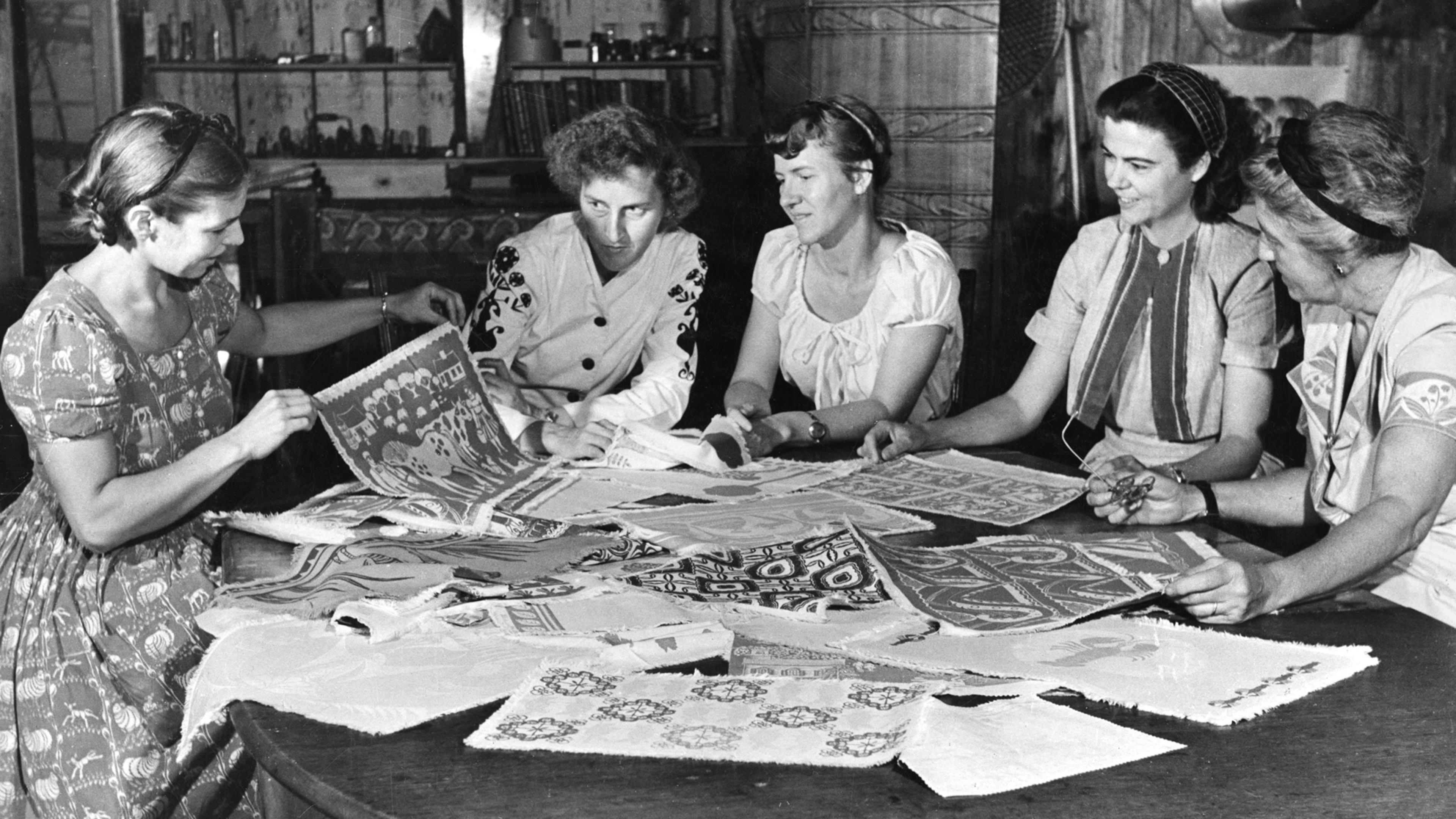A simple Yankee swap in 1938 between neighbors in the quaint neighborhood of Folly Cove, in Gloucester, Massachusetts—design lessons in exchange for music instruction—became the foundation of the Folly Cove Designers, one of the longest-running and most successful juried artist guilds in American history. Renowned children’s book author and illustrator Virginia Lee Burton (of Mike Mulligan and His Steam Shovel fame) traded design lessons in exchange for violin lessons for her sons, leading to community-wide design classes and, ultimately, the formation of the famed eponymous block-printing collective, which operated from 1941 through 1969.
As a Folly Cove designer, Virginia used her married name, Virginia Lee Demetrios. Over time at least 40 people became members. Several husband-and-wife couples joined the group, as well as a few male members, but women dominated the membership. Ultimately the group produced more than 300 distinct designs conveying personal and regional narratives through the use of shared design principles taught to them by Virginia.
Within the first 10 years of organizing, the Folly Cove Designers were propelled to international fame through commercial contracts with major retailers (Lord & Taylor and F. Schumacher & Co.) and articles about the group in national periodicals such as Life. Despite this success (and their connection with some of the most powerful people in the fields of craft and design during World War II and the postwar period), over time the story of the Folly Cove Designers has in large part receded into the annals of local history.
The inspiration for the Folly Cove designs originated from the flora and fauna of Cape Ann. After a rail line connecting Boston and Gloucester was built in the middle of the 1800s, Gloucester emerged as an artist destination. Folly Cove in particular, located on Gloucester’s north shore, with its rugged beauty, has inspired generations of artists. By the late 1930s, Folly Cove was an established artist community.
Cape Ann’s roots as an artist community are intertwined with printmaking. Gloucester native Fitz Henry Lane’s artistic career began with lithography in the 1830s. The women artists of Folly Cove who preceded the Folly Cove Designers, including Gabrielle de Veaux Clements, had established themselves in the field of etching in the late 1800s.
American art in the late 1930s, printmaking and textile design specifically, was undergoing a movement toward modernism. Prior to, during, and following World War II, artists fleeing Europe settled in the United States and brought with them a bold, new aesthetic. Abstract Expressionism, an emotive, spontaneous form of art, evolved during World War II and cemented New York City as a center for international art.
In contrast, the Folly Cove Designers were trained to draw subjects from life and as realistically as possible. One of the other primary differences between the Folly Cove Designers and other printmaking groups at the time was that they were a juried group. Most of the members were not full-time artists, but working another job and/or taking care of a family. The goal of the Folly Cove Designers was purely to produce “good design.”
While there are some similarities between the Folly Cove Designers and other printmaking groups, they are generally unlike any of their contemporaries in style or subject matter. This individuality was part of their appeal. Virginia made it clear from the start that you didn’t have to be an artist to join the group—you just had to be willing to do the work. That meant months of “homework,” culminating in the submission of a design to the Folly Cove jury; approval brought membership to the Folly Cove Designers.
The Folly Cove Designers continue to inspire contemporary—particularly women—printmakers. There is a vast and active printmaking community on Instagram. Many women printmakers, much like many of the Folly Cove Designers, are raising their children by day and working in their studios (or often at their kitchen tables) at night. Among these printmakers, printmaking on fabric is very popular.
Many of the women in the group were college-educated, professional, working mothers at a time when research indicates that most women spent 50 hours a week on housework. Like other women, they did set the table for their families every night, only they did so while wearing aprons that they had personally designed, carved into linoleum blocks, printed, and sewn themselves. The women of the Folly Cove Designers forged their own roles in the world, something that today’s female printmakers find highly relatable.
This piece is an excerpt from the new book Trailblazing Women Printmakers.
Recognize your brand’s excellence by applying to this year’s Brands That Matter Awards before the early-rate deadline, May 3.
